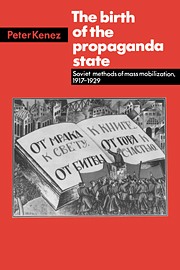Book contents
- Frontmatter
- Contents
- List of illustrations
- Preface
- Introduction: The Soviet concept of propaganda
- Part I The Civil War
- 1 The press
- 2 The struggle for the peasants
- 3 Liquidating illiteracy in revolutionary Russia
- 4 The Komsomol in the Civil War
- 5 The political use of books, films, and posters
- Part II The new economic policies
- Conclusion and epilogue
- Notes
- Glossary
- Bibliography
- Index
5 - The political use of books, films, and posters
Published online by Cambridge University Press: 02 December 2009
- Frontmatter
- Contents
- List of illustrations
- Preface
- Introduction: The Soviet concept of propaganda
- Part I The Civil War
- 1 The press
- 2 The struggle for the peasants
- 3 Liquidating illiteracy in revolutionary Russia
- 4 The Komsomol in the Civil War
- 5 The political use of books, films, and posters
- Part II The new economic policies
- Conclusion and epilogue
- Notes
- Glossary
- Bibliography
- Index
Summary
The Bolsheviks, constantly aware of the importance for winning the Civil War of bringing their message to the people, experimented with such novel methods as sending out agitational trains and ships, building a network of oral agitators, and using the youth organization for indoctrination. Of course, they also did not neglect more conventional means, for example, printing pamphlets and pasting slogans on the wall.
The attitude of the new leaders to the publishing trade, the film industry, and graphic artists was at least partially determined by propaganda needs. However, policies of the Soviet regime in this area were also affected by considerations that went beyond the problems of agitation. These policies followed from Bolshevik ideas about culture and from their ambivalent relationship with the intelligentsia. On the one hand, the revolutionaries had a high appreciation for the role of ideas in the historical process and an admiration for “culture”; on the other, they distrusted intellectuals and despised traits that were traditionally associated with them, such as moral scruples, interminable and seemingly aimless discussions, and sentimentality.
In the eyes of the Bolshevik leaders, publishing had a far greater importance than making movies or drawing posters. The book, after all, was the chief vehicle of culture, and the printed word an essential method of propaganda. By contrast, in the prevailing conditions the cinema could not play a truly important role. After all, how could a vital political message be reliably conveyed to a large group of people through the medium of film when there was often no electricty even in the city? Filmmaking was a complex, slow, and expensive business, and the regime needed cheaper and more flexible ways of winning over the people.
- Type
- Chapter
- Information
- The Birth of the Propaganda StateSoviet Methods of Mass Mobilization, 1917-1929, pp. 95 - 118Publisher: Cambridge University PressPrint publication year: 1985



